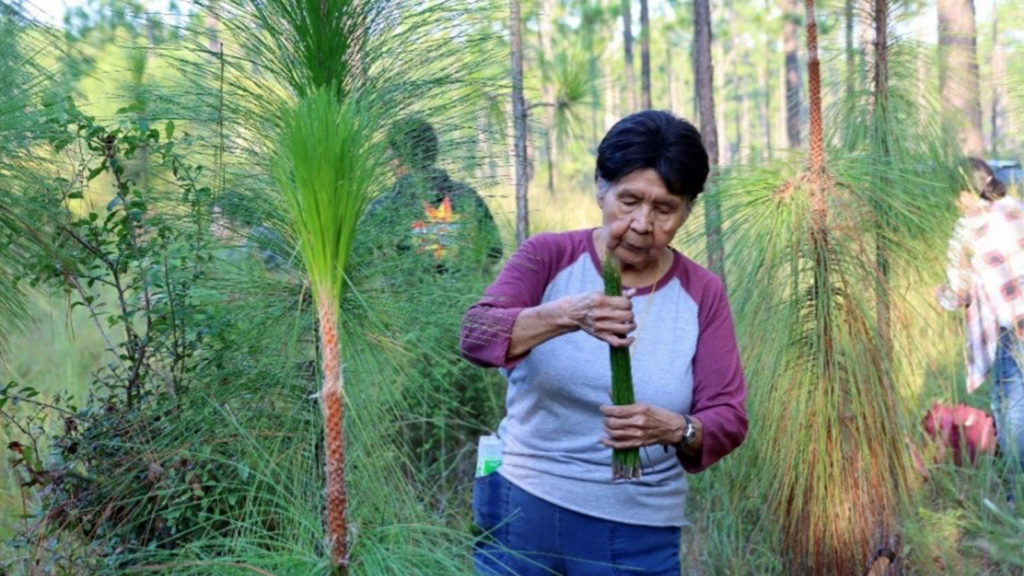
U.S. DEPARTMENT OF AGRICULTURE Forest Service, Sheila Holifield ,
Unit: Southern Region, Office of Communication
When Elliott Abbey was a boy, he would collect pine needles and pinecones from the forest with his aunts, which they later turned into pine needle baskets. Today, he credits that tribal tradition as planting the seeds of his success.
“Little did I know all of those long days harvesting pine needles, learning the steps it takes to make a basket and just gathering up and hearing them talk while working on them was a foundation that was planted within me from a very early age,” said Abbey, a member of the Coushatta Tribe of Louisiana – Wildcat Clan.
At the time, Abbey did not understand the importance of the work. Eventually, he began to see its importance through the time and energy they put into making each basket.
His aunts were well known for their basketry, one even having baskets on display at the National Smithsonian Museum. They encouraged him to take care of his talents, because one day they will take care of you.
“The art of basket weaving, or basket sewing is just one of those things that is inside you; you either have it or you don’t. It takes a lot of patience to form baskets, and it takes a lot of discipline, work and hours to continue creating them,” Abbey said.
Traditions Shared

For Native American communities, the forest has long provided the means for economic stability and growth.
“Just as we must conserve the health of our forests, allowing the forest to give back to us, so must we also conserve our legacies and traditions and pass them on from generation to generation,” Abbey said.
The practice of passing down traditions from generation to generation helps preserve heritage, builds connection to ancestors and ensures that valuable knowledge and skills are not lost.
Longleaf pine needle basket sewing is one of those rich traditions shared through generations in the southeastern United States.
This timeless craft involves the creation of intricate baskets using the long, tough needles of the longleaf pine tree to create sturdy, durable and often ornate baskets. These baskets were traditionally used for a variety of purposes, including carrying food, water and other essentials.
Abbey’s cousin, Raynella Fontenot, is a citizen of the Coushatta Tribe of Louisiana and recounted being taught the specific order to basketweaving.
“We learned from our elders the steps involved in basket making. There’s a proper way to approach the trees, a proper way to select healthy needles to gently pick so that the tree continues to produce more needles for future generations, an orderly way of gathering bundles and laying them neatly to dry,” Fontenot shared.
Deeper than the steps involved, you must also pay attention to your feelings.
“Don’t make baskets if you are having a bad day, because we were taught your feelings while you are creating them will follow each basket,” Fontenot said.
Maintaining access to longleaf pine forests is important, as these traditions are cherished among tribal nations because of their historical significance and cultural ties.
Restoring Longleaf Pine
Longleaf pine restoration is complex and requires collaboration between Tribal Nations, landowners, government agencies and conservation organizations.
In collaboration with the USDA Forest Service, tribes are gaining additional hands-on experience while learning about longleaf pine restoration and preserving their significant cultural heritage associated with forests, all while building and maintaining long-lasting partnerships.
Longleaf pine forests once dominated the southeastern United States, covering more than 90 million acres across the Coastal Plain, from southern Virginia, to Florida, to East Texas. The longleaf pine tree is known for its long, slender needles and fire-resistant properties. After nearly vanishing – about 99% of the historical longleaf pine acres are gone – there are now about five million acres of longleaf pine ecosystem. The decline was due to a growing metropolitan population and loss of forest land due to urban growth and development and fire suppression.
As our forests work to regulate our climate, clean the air we breathe, and filter the water we drink, the Forest Service and partners are intentional about keeping our forests in sync.
“Conserving longleaf pine is critical to water quality resources, recreation, and habitat protection, and will ensure its enjoyment for generations to come,” Forest Service Southern Region Director of Cooperative Forestry Kay Reed said.
Recognizing longleaf pine’s importance, public and private organizations joined together to form America’s Longleaf Restoration Initiative, with the goal of increasing longleaf pine and restore and conserve longleaf pine ecosystems across its historical range.
In 2023, the collaborative celebrated 2.17 million acres of longleaf management activities across the nine-state historic range. To date, partners have contributed to more than 23.8 million acres of longleaf management activities across the historical range, and the initiative is celebrating its initial 15 years of partnership while simultaneously keeping an eye to the future.
For the Coushatta Tribe of Louisiana, this focus on preservation of the longleaf pines will help the tribe to preserve their cultural traditions and allow them to weave their baskets long into the future.
To learn more about the America’s Longleaf Restoration Initiative, visit https://americaslongleaf.org/.



